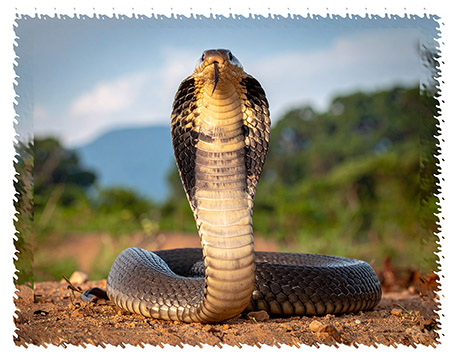

Cobra Snake Plush Toys
Find Cobra Snake stuffed animals, facts and information at Animals N More.
You can see the Hansa plush Cobra (above center) at our sponsor's online gift shop, as well as the Safari cobra figurines. You can find Cobra stuffed animals and gifts in our sponsor's online Gift Shop.
The Indian Cobra, Naja naja, is well known due to its impressive hood. Of the seven species of Cobra that dwell in Africa or Asia, none stages a more magnificent performance than the Indian Cobra. It accomplishes this by raising and pushing forward the long ribs behind its neck. It stretches its elastic skin taut over the framework, forming a flattened area that may be almost four times as wide as the diameter of its body! The hood of some Indian cobras is ornamented with two joined eyelike markings - the "spectacle." Others have a white circle bordered with black, to for m a pattern resembling a target on the back side of the hood.
m a pattern resembling a target on the back side of the hood.
Few sights are more terrifying to the uninitiated than the remarkable pose of an alarmed Indian cobra with a third or more of its body raised upright. Like the clucking and ruffling of feathers by a setting hen, or the rattle of the rattlesnake, the posture of the cobra serves the purpose of frightening the enemy.
To add to the effect, the cobra generally hisses loudly when in this upright position. Furthermore, the cobra can strike from this position, inefficiently as compared with a viper to be sure, but dangerously enough.
The Indian cobra is found throughout most of southern Asia, as well as in the Philippines and the Indo-Malayan Archipelago, as far east as the Celebes. It is equally at home in the jungle, in open fields, or around human habitations. It is not an aggressive snake, usually retreating when an avenue of escape is open to it. Mice, rats, frogs, toads, and - to a lesser extent - birds or other snakes are the principal element of its diet.
The Indian cobra mates in January and February, but does not lay eggs until May or later. The parents tend to remain paired until the young hatch, one parent or the other guarding the eggs. As many as 45 - though usually far less, are deposited in some hole in the earth. The hatchlings are 10 to 12 inches long, and they more than double their length in the first year of life. By the end of 4 years they are nearly 5 feet long. This approximates the usual adult size, lengths of 7 feet being rare.
Class: Reptilia | Order: Squamata | Family: Elapidae | Genus: Naja | Species: N. naja
image of cobra courtesy of Nova Development Art Explosion


